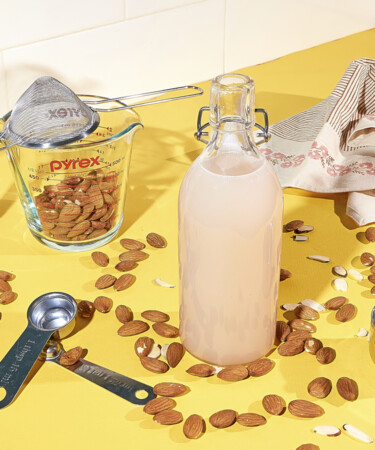Beloved for its rich nuttiness, orgeat is a crucial, complexity-cranking component in tropical builds and old-school classic cocktails alike. The sweetened syrup, traditionally made with almonds and orange blossom water, offers a light florality and milky weight to builds like the Mai Tai, the Cameron’s Kick, and the Fog Cutter. But not all orgeats are created equal, especially when they’re store-bought, which means making it at home may be your best bet for successful cocktails. To learn the art of DIY orgeat-ing, VinePair spoke with beverage director Kyle Sheridan, who has whipped up several house-made orgeats at Manhattan cocktail bar Jean’s.
According to Sheridan, store-bought orgeats will typically contain much higher concentrations of sugar and artificial sweeteners that taste more cloying than confectionery. This intense sweetness and artificial flavor, he explains, can really dominate a cocktail’s overall flavor profile, especially when other, delicate high-quality ingredients are at play.
“That flavor can completely sway a cocktail in a different direction than how it should be tasting,” he says. “Orgeat is such a delicate syrup, you don’t want anything potentially interacting with your flavors in a negative way. When you make your own, you have more control over this possibility.”
There’s also the issue of shelf life. Orgeat was originally created to store calories and nutrition to get the French through long winters centuries ago, as the syrup has an extensive lifespan and can be stored for months on end without spoiling. But as Sheridan points out, the overwhelming majority of store-bought orgeat is housed in plastic bottles, which can leach into the syrup and impart an almost rubber-like undertone.
Quality aside, Sheridan explains that the major benefit of making your own orgeat is the possibility of exploration. “Since I started cocktail consulting, I’ve always said that it’s really not that difficult to make your own orgeat, and you can play with so many different flavor combinations,” he says.
At Jean’s, Sheridan makes a pistachio-rose orgeat for the bar program’s Mai Tai instead of the standard almond orgeat. The pistachio, he says, elevates the nutty notes in the cocktail’s dark rum base while the rose delicately complements the build’s yuzu citrus juice. He’s also experimented with pink peppercorn orgeat and peach pecan orgeat.
Getting creative doesn’t just mean changing up the orgeat itself — it also opens the door to adding the nutty syrup to unexpected builds. In the past, Jean’s featured its pistachio-rose orgeat in its Margarita. According to Sheridan, the pistachio element wonderfully highlighted the barrel-aged notes of the drink’s Komos Reposado Rosa while the orgeat’s rose water brightened the tequila’s floral undercurrent.
When it comes to actually making orgeat yourself, Sheridan first recommends determining which flavor profiles you’re actually looking to achieve with your cocktails. (Our recommendations: Try pairing walnuts with Irish whiskey, almonds with vodka, macadamias with dark rum, and pecans with bourbon.) And as nuts can be extremely expensive, he advises starting in small batches to nail the flavor profile before using up all your stock. After that, you can scale up.
But his No. 1 recommendation? Remember that it’s more than fine to experiment.
“With orgeat, you can kind of do anything,” he explains. “Don’t be afraid to go with something different than almonds and orange blossom water. Have fun with it. Do something unexpected.”
Jane’s Pistachio & Rose Orgeat
Ingredients
- 4 cups ground pistachios
- 2 cups pistachio paste (or 6 cups ground pistachios)
- 1 ½ liters water
- 1 ½ teaspoons rose water (more if needed)
- Sugar as needed (1:1 ratio with final liquid extraction)
Directions
- Bring 1 ½ liters of water to a roaring boil.
- Add pistachio paste to water and whisk to combine.
- Add ground pistachios while continuously stirring.
- Add rose water and stir to combine, allowing mixture to come back to a boil.
- Stir constantly in order to prevent ingredients from burning.
- Once boiling, lower heat to a simmer and allow to sit for 45 minutes, stirring occasionally.
- After 45 minutes, remove from heat and pass through a strainer lined with a cheesecloth. Squeeze the cheesecloth to extract most of the liquid, but do not oversqueeze sediment.
- Measure liquid and add the equivalent amount of sugar and whisk to dissolve.
- Add more sugar or rose water as needed to achieve desired flavor.
